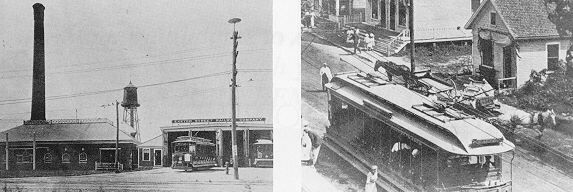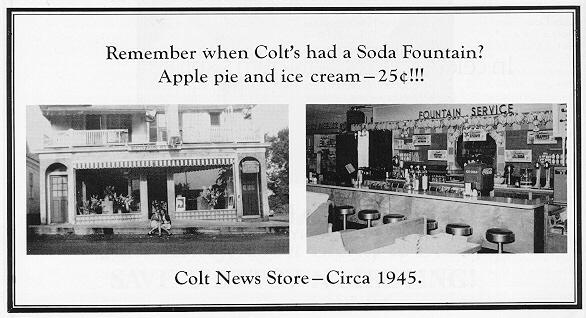Official Souvenir Program Book
January 1 – December 31, 1988
By Gerald A. (Jerry) McConnell

Photo right: Whittier Junction, Hampton Village.
The Hotel Whittier is on the left background.
January of this year not only begins the 350th Anniversary of our town, it also marks the sixty-second anniversary of a nostalgic event which significantly shaped the future of our town, when in January 1926, the last trolley car ran in this area. In the book Trolleys to the Casino, by O. R. Cummings, the full story of trolley railway transportation in this area is told. A small part of that information is recorded here.
The Exeter Street Railway was the first to be chartered by the New Hampshire Legislature on August 7, 1889. It was to be operated by any power other than steam for transportation of persons and property from the railroad depot in Exeter to the neighboring towns and to Hampton Beach. It was proposed to build initially from Exeter to Hampton Village and Hampton Beach, a distance of slightly more than eleven miles. After two years the railway had met with little success at fund raising and a group of Hampton men, who felt that the railway would never materialize, organized the Hampton Street Railway to run from Hampton Village to Hampton Beach. This new company was chartered by the legislature on April 11, 1891. But as did the Exeter Street Railway, the Hampton Street Railway remained dormant. Six years later in early 1897, a Wallace D. Lovell of West Newton, Mass., and a number of associates, acquired control of the rights to the Exeter Street Railway’s unused charter. The Lovell group formed the Franklin Construction Company to handle the building of the railway and also organized the Rockingham Electric Company in March 1897. The electric company was to purchase power from the parent company, the Exeter Street Railway, and sell the energy to the towns of of Exeter and Hampton. The company then obtained locations and franchises in Exeter and Hampton and construction actually began with a route beginning at the Exeter Depot on Lincoln Street, out High Street to Hampton Road, which became Exeter Road after crossing the Hampton Boundary at Dow’s Hill, to Hampton Village, crossing the Boston and Maine railroad tracks near the Hampton Depot. In Hampton Village the tracks were to extend southerly on Lafayette Road to Whittier’s Corner and then curve easterly on Winnacunnet Road, continuing on to Ocean Boulevard at Hampton Beach. Turning southerly at the beach it would extend along the seaward side of the boulevard passing Great Boar’s Head and terminating at a point
opposite Cutler’s Sea View House (later the Hotel Allen).
The first construction began in April of 1897 on the grading between Hampton Village and Hampton Beach. The track laying began a month later on May 19,1897 when Judge Charles M. Lamprey of Hampton drove the first spike at a place on Winnacunnet Road at Whittier’s Corner. From then on, progress was steady. Service between Hampton Village and Hampton Beach actually commenced on Sunday, July 4,1897 and by the following Saturday, July 10th, the line was basically complete all the way from Hampton Beach to the great bridge in Exeter. On Sunday, July 18th, the first car from Hampton entered Court Square (Junction of Water and Front Streets) in Exeter, and about two weeks later on August 2nd, the last rail was laid and the final spike driven on Main Street and the Exeter Street Railway was complete. All of this in just four months.
Photo right: Lafayette Road stop. Colt’s & Earl’s Barber Shop at top.
The first power station for the Exeter Street Railway was constructed approximately one and one half miles west of Hampton Village on Exeter Road near a small pond, now known as Car Barn Pond, near the intersection of Timber Swamp and Exeter Roads, where the buildings can still be seen today.
As an example of how industrious was the group formed by Mr. Lovell, it must be noted that in the same year of 1897, eight years after the first charter was granted, and less than one year after the first construction had begun, plans were announced to extend the line from Hampton Village through Hampton Falls to Smithtown Square in Seabrook and the Massachusetts boundary, thence on through Salisbury Plains to the thriving industrial town of Amesbury. Due to the limitations of the Exeter Street Railway’s charter, it could build only that portion of the proposed route between Whittier’s Corner and the Hampton Falls boundary, so a new company was organized to construct the tracks through Hampton Falls and Seabrook to the state line. This new company was called the Hampton and Amesbury Street Railway. Another new corporation was required to own a section of the projected line from the Massachusetts border to Amesbury: this new company was called the Amesbury and Hampton Street Railway. In May 1899, the construction was complete and service began. During this time, the Haverhill and Amesbury Street Railway extended its line from Salisbury Square to Smithtown making it possible for the first time to ride by trolley all the way from Boston to Exeter and Hampton Beach. Also during this time the Exeter Street Railway began extending its track from Cutler’s Sea View House southerly along Ocean Boulevard to the Hampton River and plans were announced for the erection of a large casino on Ocean Boulevard.
Work began in April 1899 and it was sufficiently complete to permit its being open to the public on July 4th. Also built in the spring and summer of 1899 was a two mile extension northerly along Hampton Beach from Winnacunnet Road to the North Hampton Boundary near Little Boar’s Head to connect with the Portsmouth Electric Company line under construction at the time. This extension was completed but could not be placed in operation until 1900 when the Portsmouth Electric Company completed its main line from the port city to Rye Center, Rye Beach and Little Boar’s Head.
On February 15, 1899, the New Hampshire State Legislature granted a corporate charter to the Exeter, Hampton and Amesbury Street Railway which was a consolidation of the Exeter Street Railway, the Hampton and Amesbury Street Railway and the Rockingham Electric Company. This incorporation also was authorized to conduct a general electric lighting and power business in the towns of Exeter, Hampton, Hampton Falls and Seabrook. The newly unified railway system consisted of twenty six miles of track from the Exeter Depot to Hampton Village and Beach thence to a point southerly to the Hampton River and northerly to the Portsmouth Junction at Little Boar’s Head. It also included the track from Whittier’s Corner to Market Square in Amesbury.
The opening of this rail service was probably the beginning of what was to become Hampton’s largest attraction, tourism to Hampton Beach. It allowed people from Exeter to Hampton to Amesbury to visit each other’s towns more readily and it probably helped facilitate the expansion of electric service to most of the homes and businesses in those towns. The trolleys are gone. The nostalgia of the past remains only in pictures.
Would that they were back!

